AUDI RS7 SPORTBACK 2015 Owners Manual
Manufacturer: AUDI, Model Year: 2015, Model line: RS7 SPORTBACK, Model: AUDI RS7 SPORTBACK 2015Pages: 302, PDF Size: 74.76 MB
Page 221 of 302
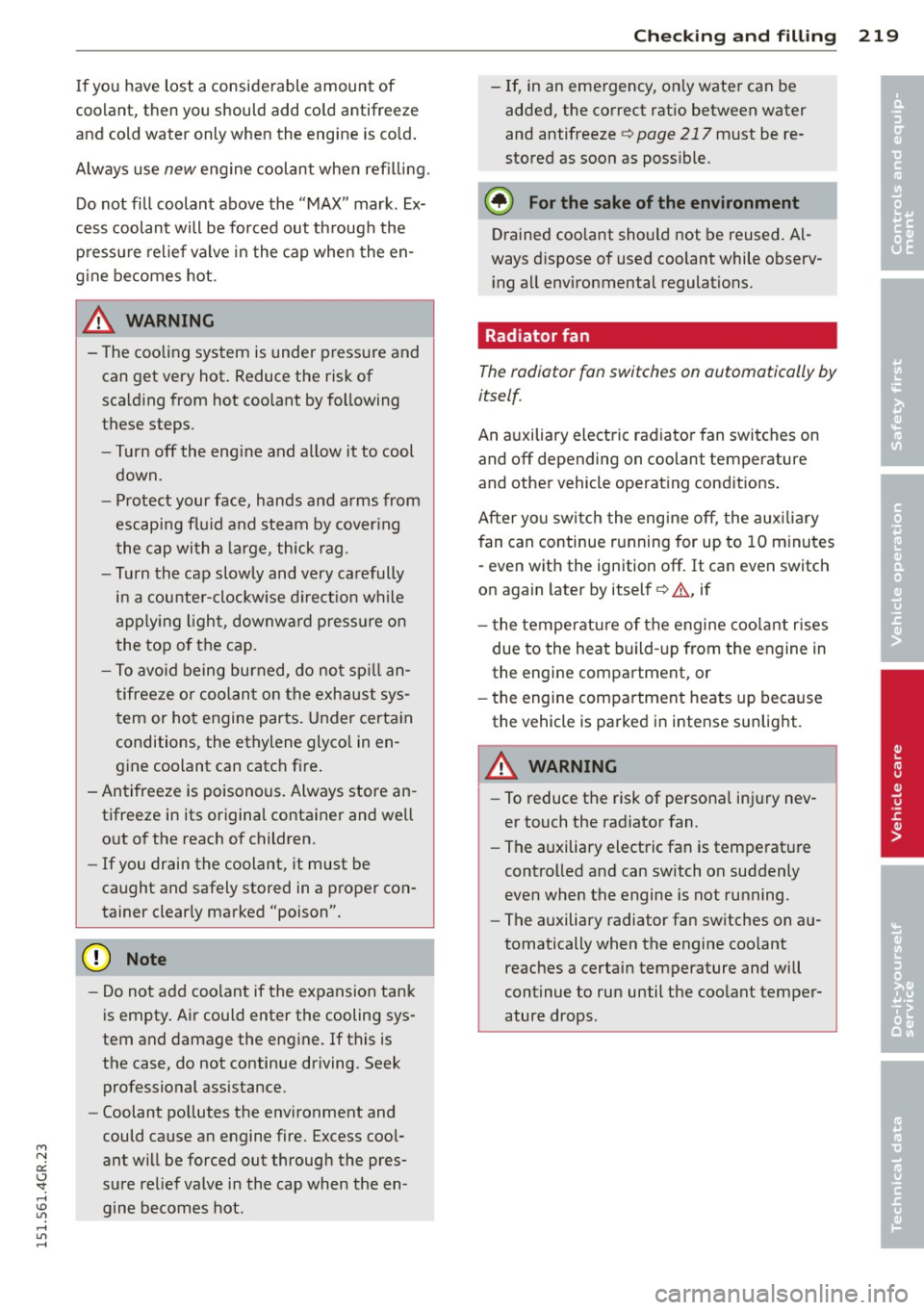
M N
0:: <.J 'SI: ,...., \!) 1.1'1 ,...., 1.1'1 ,....,
If you have lost a consi derable amount of
coolant, then you should add co ld antifreeze
and cold water only when the engine is co ld .
Always use
new engine coolant when refi lling.
D o not fi ll coolant above the "MAX " mark . Ex
cess coolant will be forced out th rough the
p ress ure rel ief valve in the cap when the en
g ine becomes hot .
A WARNING ,_________
-The cooling system is under press ure and
can get very hot . Reduce the risk of
sca ld ing from hot coo lant by following
these steps.
- Tur n
off the eng ine and a llow itto cool
down.
- Protect your face, hands and arms from
escap ing f lu id a nd steam by cover ing
the cap wi th a la rge, thick rag.
- Turn the cap slow ly and very ca refully
in a cou nte r-clockw ise d irect ion while
a pply ing ligh t, downw ard p ress ure on
the to p of the cap.
- To avo id being burned, do no t sp ill an
tifreeze or coolan t on t he exhaust sys
tem or ho t engine parts . U nder certa in
conditions, the ethylene glyco l in en
gine coolant can catc h fire .
- Antifreeze is poisonous . Always store an
tifreeze in its original container and we ll
o ut o f the reach of children.
- If you drain the coolant , it must be
caught and safely stored in a proper con
tainer clearly marked "poison".
@ Note
- Do not add coolant if the expansion tank
i s empty . Ai r could enter the cooling sys
tem and damage the engine. If this is
the case, do not continue driving. Seek professional assistance.
- Coolant po llutes the env ironment and
could cause a n engine fire. Excess coo l
ant wi ll be forced out through the pres
sure re lief valve in the cap when the en
gine becomes hot.
Checkin g and fillin g 219
-If, in an emergency, on ly wate r can be
added, the correct ratio between water
and antifreeze ¢
page 217 must be re
stored as soon as possible.
@) For the sake of the environment
Drained coolant sho uld not be reused. A l
ways d ispose of used coolant while observ
i ng a ll environmental regulations.
, Radiator fan
The radiator fan switches on automatically by
itself .
An auxiliary electric radiato r fan switches on
and
off depending on coolant temperature
and othe r vehicle ope rat ing cond it ions.
After yo u switch the eng ine o ff, the aux iliary
f an can continue running for up to 10 m inutes
- even with the ignition off. It can even switch
on aga in later by itself¢ .&. , if
- the temperatu re of the engine coo lant rises
du e to the h eat build -up from th e engin e in
the engine compa rtment, or
- the engine compa rtment heats up because
the vehicle is parked in intense sunlig ht.
A WARNING ~
- To reduce the risk of persona l inju ry nev-
er touch the radiator fan .
- The a uxiliary electric fan is tempe rat ure
contro lled and can switch on suddenly
even when the engine is not running.
- The a uxiliary radiator fan sw itches on a u
tomatically when the engine coo lant
reaches a certai n temperature and will
continue to ru n until the coo lant temper
ature drops. •
•
Page 222 of 302
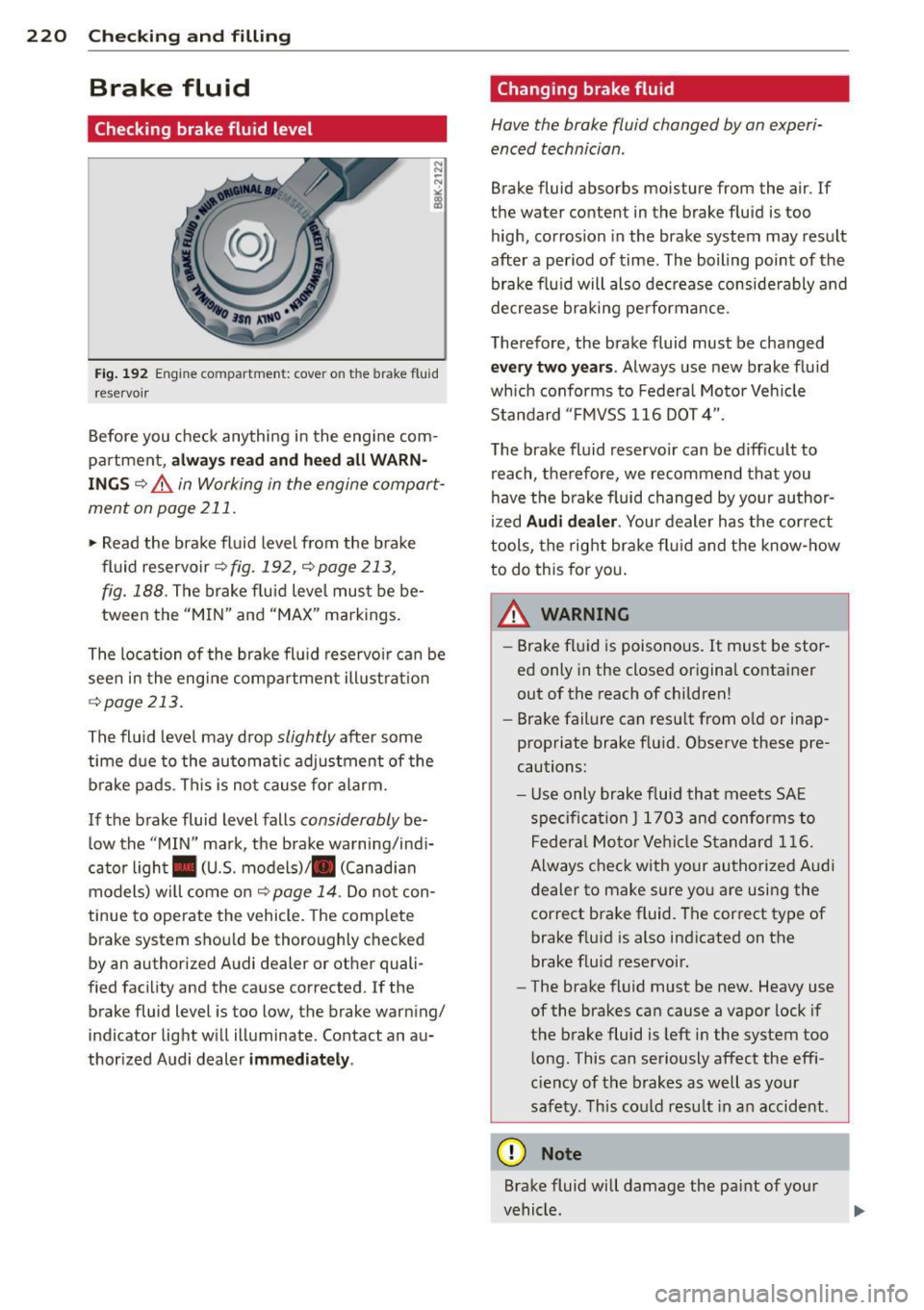
220 Checking and filling
Brake fluid
Checking brake fluid level
Fig . 192 Engine compar tment: cove r on the brake fl uid
reservo ir
Before you check anything in the engine com
partment,
always read and heed all WARN
INGS ¢&. in Working in the engine compart
ment on page 211.
,.. Read the brake fluid level from the brake
fluid reservoir¢
fig . 192, ¢ page 213,
fig. 188 .
The brake fluid level must be be
tween the "MIN" and "MAX" markings.
The location of the brake flu id reservoir can be
seen in the engine compartment illust rat ion
¢ page 213.
The fluid level may drop slightly after some
time due to the automatic adjustment of the
brake pads. This is not cause for alarm.
If the brake fluid level falls
considerably be
low the "MIN" mark, the brake warning/indi
cator light . (U.S. models)/ . (Canadian
models) will come on ¢
page 14. Do not con
tinue to operate the vehicle. The comp lete
brake system shou ld be thoroughly checked
by an authorized A udi dealer or other quali
fied facility and the cause corrected.
If the
brake fluid level is too low, the brake warning/
indic ator light will illuminate. Contact an au
thorized Audi dealer
immediately .
Changing brake fluid
Have the brake fluid changed by an experi
enced technician .
Brake fluid absorbs moisture from the air. If
t he water content in the brake fluid is too
high, corrosion in the brake system may result
after a period of time . The boiling point of the
brake flu id will also decrease conside rably and
decrease braking pe rformance.
Therefore, the brake fluid must be changed
every two years . Always use new brake flu id
which conforms to Federal Motor Vehicle
Standard "FMVSS 116 DOT 4".
The brake fluid reservoir can be difficult to
reach, therefore, we recommend that you
have the brake fluid changed by your author
ized
Audi dealer. Your dealer has the correct
tools, the right brake fluid and the know-how
to do this for you.
A WARNING
- Brake fluid is poisonous . It must be stor
ed only in the closed original container
out of the reach of children!
- Brake failure can resu lt from o ld or inap
propriate brake fluid. Observe these pre
cautions:
- Use only brake fluid that meets SA E
specification
J 1703 and conforms to
Federal Motor Vehicle Standard 116.
Always check with your authorized Audi
dealer to make sure you are using the
correct brake fluid. The correct type of
brake f luid is also indicated on the
brake fluid reservoir.
- The brake fluid must be new. Heavy use
of the brakes can cause a vapor lock if
the brake fluid is left in the system too
long . This can seriously affect the effi
c ie ncy of the brakes as well as your
safety. This could resu lt in an accident.
(D Note
Brake fluid will damage the paint of your
vehicle .
Page 223 of 302
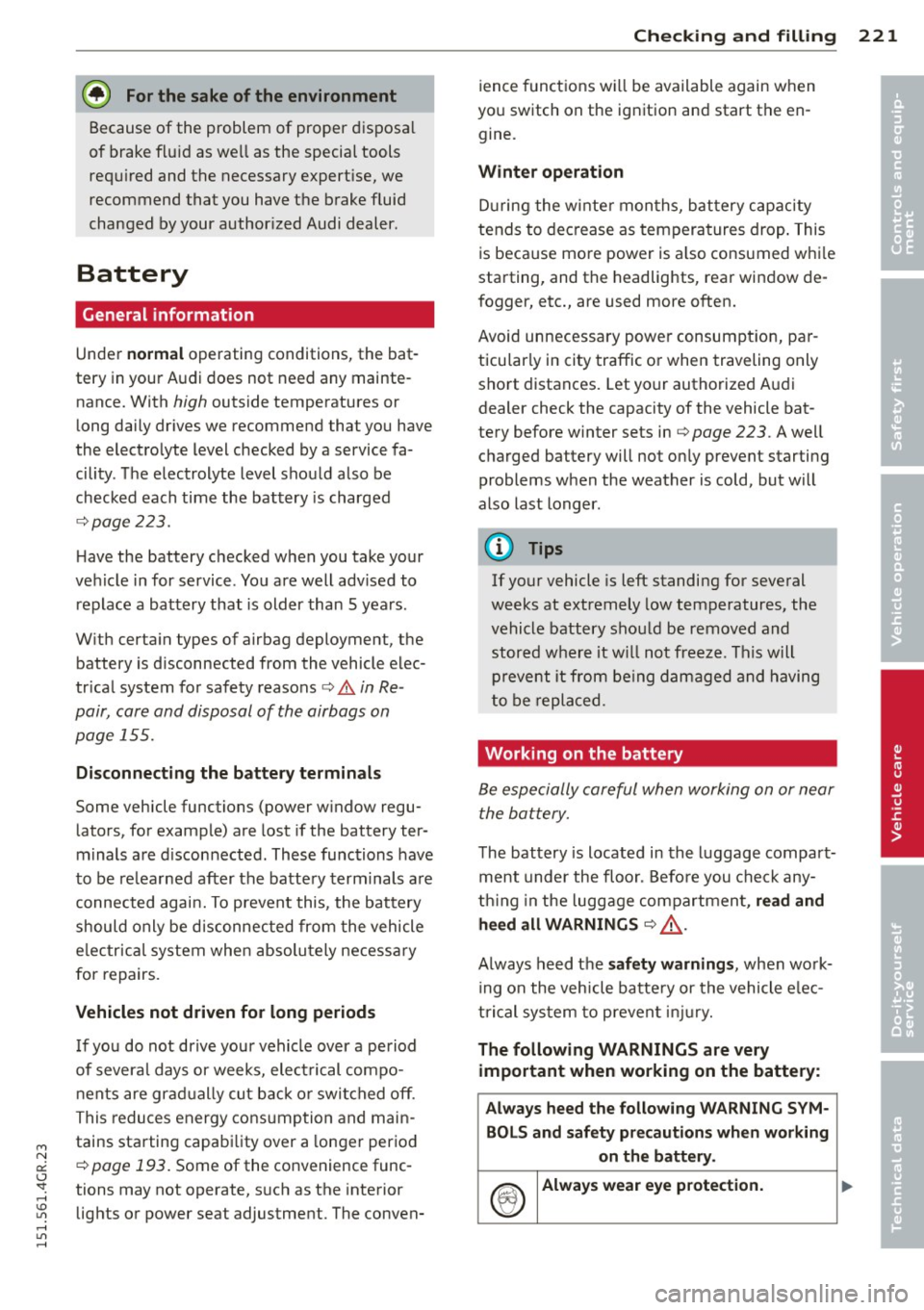
M N
0:: <.J 'SI: ,...., \!) 1.1'1 ,...., 1.1'1 ,....,
@ For the sake of the environment
Because of the pr oblem of proper d isposa l
of brake flu id as we ll as the special tools
requ ired and the necessary expert ise, we
recommend that you have the brake fluid
changed by your author ized Audi dealer .
Battery
General information
Under normal operating conditions, the bat
tery in your Audi does not need any mainte
nance. With
high outside temperatures or
long daily dr ives we recommend that you have
the electro lyte level checked by a service fa
cility . The electrolyte level shou ld also be
checked each time the battery is charged
¢ page 223.
Have the battery checked when you take your
ve hicle in for service . You are well adv ised to
replace a battery that is older than 5 yea rs .
W ith certa in types of a irbag deployment, t he
b attery is d isconnected from the vehicle elec
tr ica l system for safety reasons¢.&.
in Re
pair, core and disposal of the airbags on
page 155.
Disconnecting the battery terminals
Some vehicle functions (power w indow regu
lators , for example) are lost if the battery ter
m inals a re d isconnected. These func tions have
to be re lea rned after the batte ry term inals a re
connected agai n. T o prevent this , the bat tery
should only be d isconnec ted from the vehicle
e lec tric al system when absolu tely necessa ry
for repairs .
Vehicles not driven for long periods
If you do not drive you r vehicle over a period
of severa l days or weeks, elec trical compo
nen ts are gr adually cut b ack o r swi tched off .
This redu ces energy cons umption and main
tains starting capab ility over a longer per io d
¢
page 193. Some of the co nvenience func
tions may not operate, s uch as the inte rior
lights or power seat adjustme nt. The conven-
Checkin g and fillin g 221
ience funct ions w ill be available again when
yo u sw itch on the ign ition and start the en
gine.
Winter operation
D ur ing the w inte r mon ths, bat tery ca pa city
tends to decrease as tempera tures drop . This
is beca use more power is a lso consumed wh ile
starting, and the headlights, rear window de
fogger, etc., are used mo re often.
Avoid unnecess ary powe r consumpt ion, pa r
ticu lar ly in city traffic o r when traveling only
sho rt distances. Let yo ur authorized A udi
dealer check the capacity of the vehicle bat
tery before w inter sets in¢
page 223 . A well
charged battery will no t on ly prevent star tin g
problems w hen the weather is cold, but w ill
also last longer .
@ Tips
If your vehicle is left standing for seve ral
weeks at extremely low temperatures, the
vehicle battery s hou ld be removed and
stored where it will not freez e. This will
p reve nt it from be ing dam aged and having
to be repl aced .
Working on the battery
Be especially careful when working on or near
the bat tery.
The battery is located in the luggage compar t
ment under the floor . B efo re you che ck any
thi ng in the luggage compartment,
read and
heed all WARNINGS
¢ .&, .
Always heed the safety warnings , when work
i ng on the veh icle batte ry or t he vehicle e lec
t rical sys tem to p reven t inju ry.
The following WARNINGS are very
important when working on the battery:
Always heed the following WARNING SYM· BO LS and safety precautions when working
on the battery .
®
Always wear eye protection.
•
•
Page 224 of 302
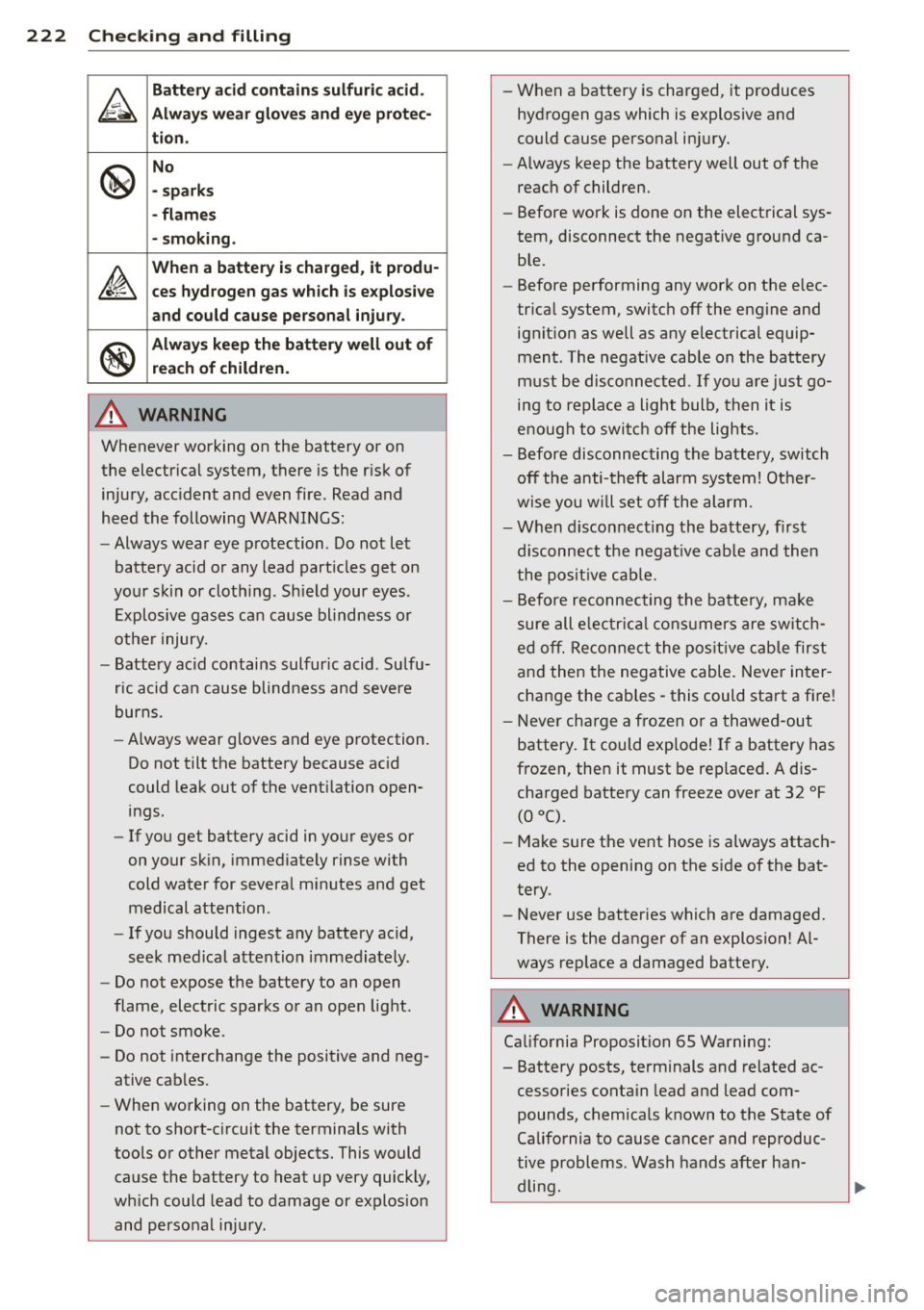
222 Check ing and filling
&
Batt ery aci d c ont ain s s ulfuric acid .
A lw ay s w ear gloves and eye protec-
ti on.
@
No
- spark s
- flame s
· sm okin g.
A
When a b atte ry is ch arged , it p rodu -
ce s hydr oge n ga s wh ich i s ex plosi ve
.
and co uld cause pe rsonal injur y.
®
Alway s keep the batt ery well out of
re ach of children.
A WARNING
Whenever working on the battery or on
the electrical system, there is the r isk of
injury, acc ident and even fire. Read and
heed the following WARNINGS:
- Always wear eye protection. Do not let
battery acid or any lead part icles get on
your sk in or cloth ing . Sh ield your eyes .
Explosive gases can cause blindness or
other injury.
- Battery acid contai ns sulfur ic acid. Sulfu
ric acid can cause blindness and severe
burns.
- Always wear gloves and eye protection.
Do not tilt the battery because ac id
could leak out of the vent ilation open
ings.
- If you get battery acid in your eyes or
on your sk in, immediately rinse with
cold water for severa l m inutes and get
medical attention .
- If you should ingest any battery acid,
seek medical attention immediately .
- Do not expose the battery to an open
flame, electric sparks or an open light.
- Do not smoke.
- Do not interchange the positive and neg-
ative cab les.
- When working on the battery, be sure
not to short-circuit the terminals with
tools or other metal objects. This would
cause the battery to heat up very quickly,
wh ich could lead to damage or explosion
and personal injury. -
When a battery is charged, it produces
hydrogen gas which is explosive and
could cause personal injury.
- Always keep the battery well out of the
reach of children.
- Before work is done on the electrical sys
tem, disconnect the negat ive ground ca
ble.
- Before performing any work on the e lec
trica l system, switch off the engine and
ignit ion as well as any electrical equip
ment. The negative cable on the battery
must be disconnected .
If you are just go
ing to replace a light bulb, then it is
e nough to swi tc h off the lights.
- Before disconnecting the battery, switch
off the anti-theft alarm system! Other
wise you wi ll set off the alarm.
- When disconnecting the battery, f irst
d isconnect the negat ive cab le and then
the posit ive c ab le.
- Before reconnecting the batte ry, ma ke
sure all e lectr ica l consumers are sw itch
ed off . Re connect the pos it ive cable first
and then the negative cable. Never inter
change the cables - this could start a fire!
- Never charge a frozen or a thawed-out
battery. It could exp lode! If a battery has
frozen, then it must be replaced . A dis
charged battery can freeze over at 32
°F
(0 oc).
- Make sure the vent hose is always attach
ed to the opening on the s ide of the bat
tery.
- Never use batteries which are damaged.
There is the danger of an explosion! Al
ways rep lace a damaged battery.
A WARNING
Ca lifornia Proposition 65 Warning:
- Battery posts, terminals and related ac
cessories conta in lead and lead com
pounds, chemicals known to the State of
California to cause cancer and reproduc
tive problems . Wash hands after han-
dling.
~
Page 225 of 302
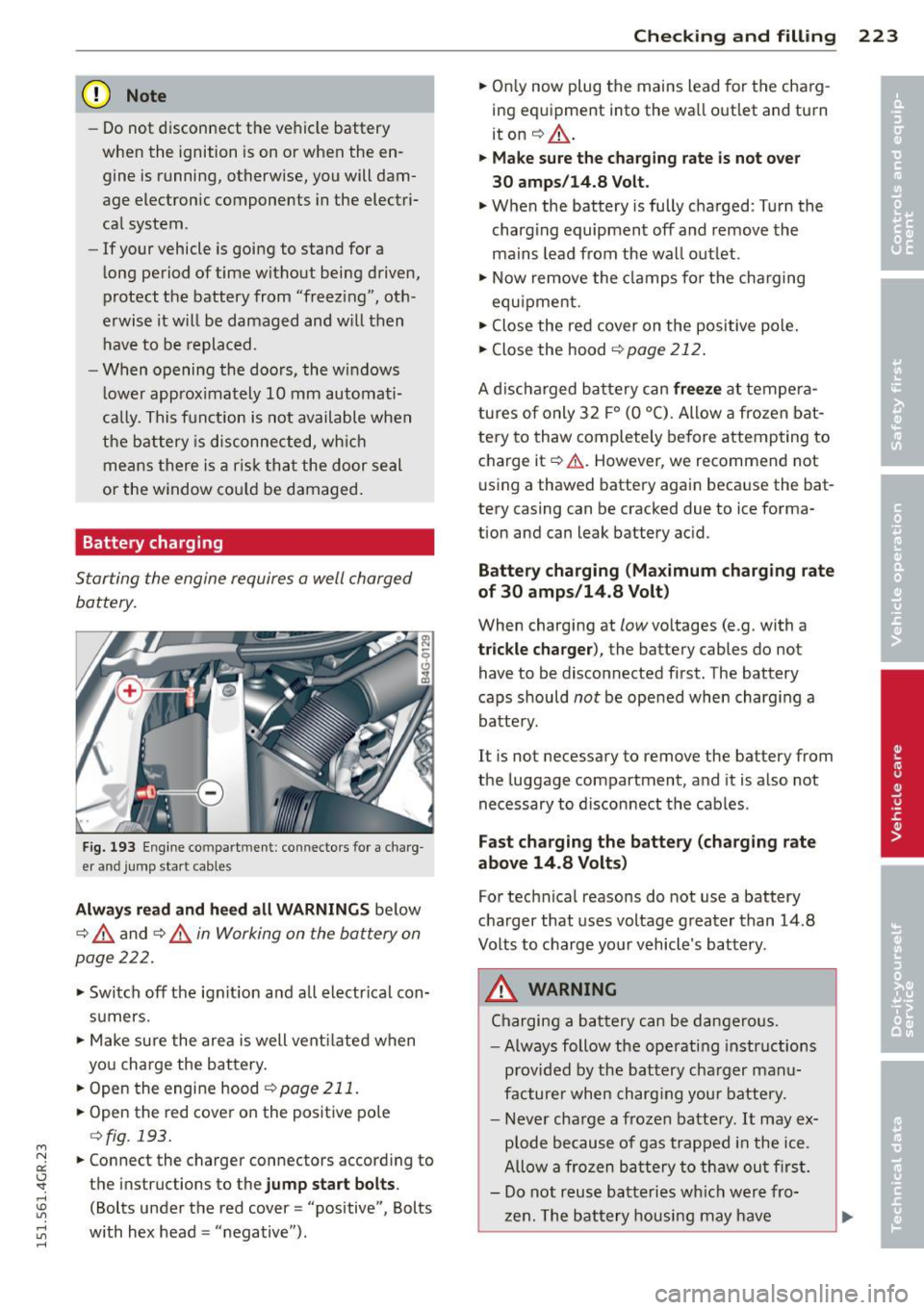
"' N
a:: I.J ""'. rl I.O
"' rl
"' rl
(D Note
- Do not disconnect the ve hicle battery
when the ignition is on or when the en
gine is running, otherwise, you will dam
age electronic components in the electri
ca l system .
- If your vehicle is going to stand for a
l ong period of time without being driven,
protect the battery from "freezing", oth
erwise it w ill be damaged and w ill then
have to be replaced .
- When opening the doors, the windows
l ower app rox imately 10 mm automati
cally. This f unction is not available when
t h e battery is disconnec ted, wh ic h
means there is a ris k t hat the door se al
or the w indow co uld be damaged .
Battery charging
Starting the engine requires a well charged bat tery.
F ig. 1 93 En gine co mpartme nt: c onnectors for a charg
er a nd jum p sta rt cable s
Always read and heed all WARNINGS below
¢ .&. and
¢.&. in Working an the battery on
page 2 22.
"'Switch off the ignit ion and all electrica l con
s u mers .
"' Make sure the area is well vent ilated when
you charge the battery.
"' Open the engine hood
c::> page 211 .
"'Open the red cover o n the posit ive pole
<=> fig . 193.
"' Connect the charger connectors accord ing to
the instruc tions to the
jump start bolts .
(Bolts under the red cover = "positive", Bolts
with hex head = "nega tiv e").
Checkin g and fillin g 223
"'On ly now plug the mains lead for the cha rg
i ng eq uipment into the wa ll outlet and turn
it on
c::> ,&. .
"'Make sure the charging rate is not o ver
30 amps /14.8 Volt .
"'When the battery is fully c harged : Turn the
charg ing equipment off and remove the
mains lead from the wa ll out let .
"' Now remove the clamps fo r the cha rg ing
equ ipme nt.
"' Close the red cover on the positive pole .
"' Close the hood ¢
page 212 .
A d ischa rged batte ry can freeze at tempe ra
tures of only 3 2 F
0 (0 °C). Allow a fro zen bat
te ry to thaw completely before attemp ting to
c h arge it
c::> & . However, we recommend not
using a thawed battery again because the bat
tery casing can be cracked due to ice forma
tion and can leak battery ac id.
Battery charging (Maximum charging rate
of 30 amps /14.8 Volt )
When cha rging at
low vo ltages (e .g. with a
trickle charger), the batte ry cables do not
have to be disconnected f irst . The battery
caps should
not be ope ned when charg ing a
batte ry .
It is not necessary to remove the battery from
the luggage compartment, and it is a lso not
necessary to d iscon nect the cab les .
Fa st charging the battery (cha rging rate
above 14.8 Volts)
Fo r technical reasons do not use a battery
c h a rger that uses voltage g reater than 14 .8
Volts to charge yo ur vehicle's battery .
A WARNING
C harging a battery can be dangero us.
- Always follow t he ope rati ng inst ructions
provi ded by the battery cha rg er ma nu
f ac turer when chargi ng you r battery.
- N ever cha rge a fro zen batte ry.
It may ex
p lode because of gas trapped in the ice .
A llow a froz en ba tte ry to thaw out first.
- D o not r euse ba tte ries wh ich were fro
z en. The bat tery housi ng may
h ave
Page 226 of 302
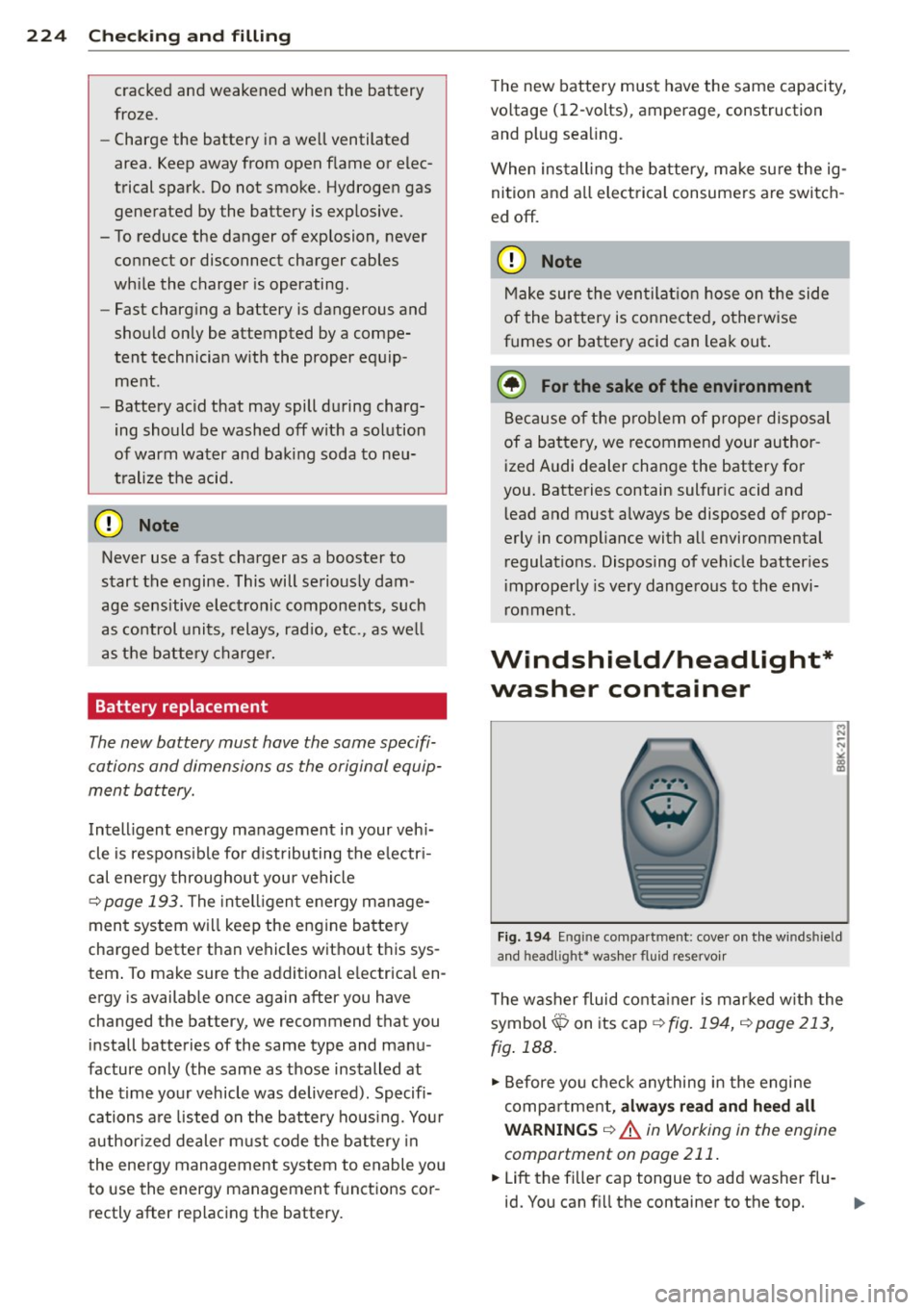
224 Check ing and filling
cracked an d weake ned when the battery
froze.
- Charge the battery in a we ll ventilated
area. Keep away from open flame or elec
trical spark . Do not smoke. Hydrogen gas
generated by the battery is exp losive.
- To reduce the danger of explosion, never
connect or disconnect charger cables
wh ile the charger is operating .
- Fast charg ing a battery is dangerous and
should only be attempted by a compe
tent technician w ith the proper equip
ment .
- Battery acid that may spill d uring charg
ing should be washed off w it h a solution
of warm water and ba kin g soda to neu
t rali ze the acid.
~ Note
Never use a fast charger as a booster to
start the engine. This will seriously dam
age sensitive ele ct ronic components, such
as co ntrol units, relays, rad io, etc. , a s we ll
as th e batte ry charge r.
Battery replacement
The new battery must have the same specifi
cations and dimensions as the original equip
ment battery.
I ntell igent energy manag ement in your veh i
cle is respo nsible for d ist ribu ting the e lectr i
cal energy throughou t you r vehi cle
~ page 193. The inte lligen t energy m anage
ment system w ill keep the engine batte ry
charged better than vehicles w it h out t his sys
tem . T o make sure the additional e lectrical en
ergy is available once again after you have
changed t he battery, we recommend that you
install batteries of the same type and manu
facture only (the same as those ins talled at
the t ime your vehicle was delivered). Specifi
cations a re listed o n the battery hous ing. You r
author ized de aler m ust code the b attery in
the ene rgy management system to enable yo u
to use the energy managemen t fu nctions co r
rectly after replac ing the battery. T
he new battery must have the same capacity,
vo ltage ( 12-volts) , amperage , construction
and plug sea ling .
When ins tall ing t he battery, make su re the ig
nition and a ll elect rical consume rs are switch
ed off .
(D Note
M ake sure the ven tilat ion hose on the side
of the ba ttery is connecte d, otherwise
fumes or batte ry acid can lea k out .
@ For the sake of the environment
B ecause o f the p rob lem of p roper disposal
of a battery, we recommen d your author
i zed Audi dea ler chan ge the battery for
you . Batteries contain sul fur ic acid and
l ead and must a lways be disposed of p rop
e rly in compliance with all environmental
regulations . Disposing of vehicle batter ies
i mprope rly is very dange rous to th e envi
r o nment.
Windshield/headlight*
washer container
Fi g. 19 4 En gin e co mpa rt m en t: cove r on t he w inds hield
a n d head ligh t* was her fl ui d reservo ir
T he washer fluid co ntai ner is mar ked w it h t he
symbol$ on its cap
~ fig. 194, ~page 213,
fig . 188.
.,. Before you chec k any thing in the engine
comp artment,
always read and heed all
WARNINGS ~ A in Working in the engine
compartment on page 211 .
.,. Lift the fi ller cap tongue to add washer flu -
id. You can f ill the container to the top. ..,.
Page 227 of 302
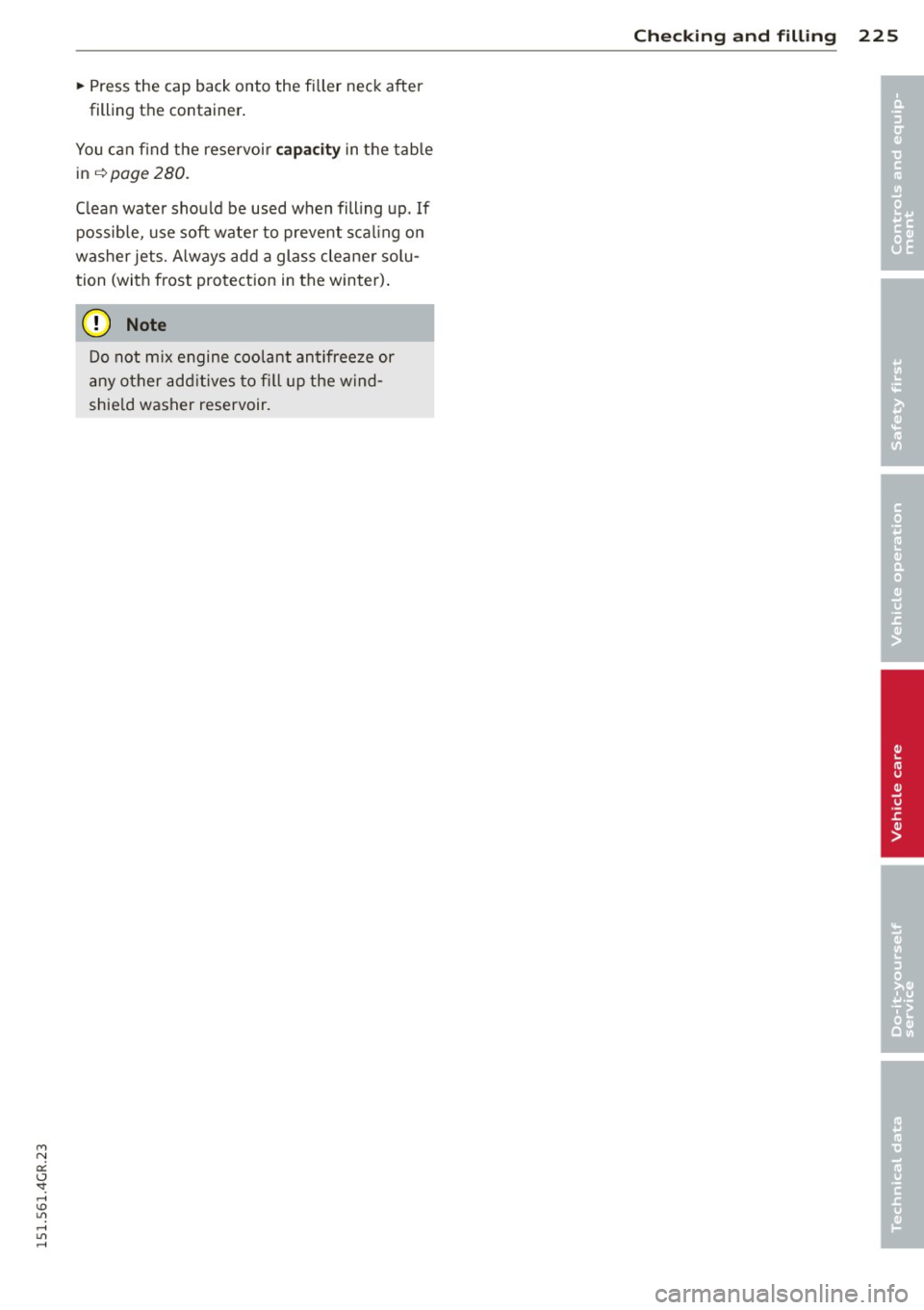
M N
0:: <.J 'SI: ,...., \!) 1.1'1 ,...., 1.1'1 ,....,
~ Press the cap back onto the filler neck after
filling the container .
You can find the reservoir
c ap acity in the tab le
in
c::> page 280.
C lean water should be used when filling up. If
possible, use soft water to prevent scal ing on
washer jets. A lways add a glass cleane r solu
tion (with frost protection in the winter) .
(D Note
Do not mix engine coolant antifreeze or
any other add itives to fi ll up the wind
shie ld washer reservoir.
Checkin g and fillin g 225
•
•
Page 228 of 302
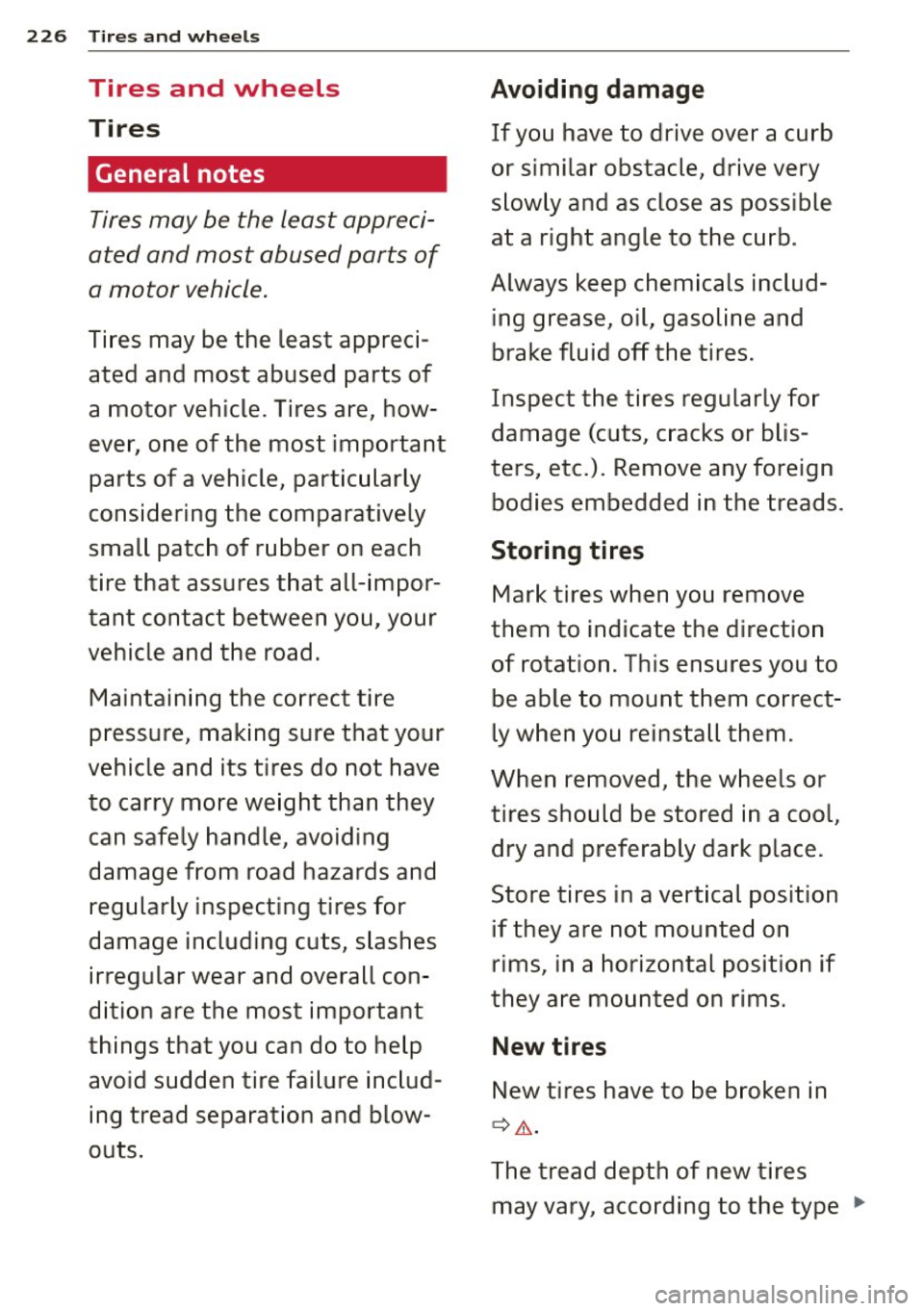
226 Tires a nd whee ls
Tires and wheels
Tires
General notes
Tires may be the least appreci
ated and most abused parts of
a motor vehicle.
Ti res may be the least appreci
ated and most abused parts of
a motor vehicle. Tires are, how
ever, one of the most important
parts of a vehicle, partic ularly
considering the comparatively
small patch of r ubber on each
tire that assures that all-impor
tant contact between you, your
vehicle and the road.
Maintaining the co rrect tire
p ressure, making sure that your
vehicle and its tires do not have
to carry more we ight than they
can safe ly handle, avoiding
damage from road hazards and
regular ly inspecting tires for
damage including cuts, s lashes
irregular wear and overall con
d ition are the most important
things that you can do to help avoid sudden tire fai lure inc lud
ing tread separation and blow
outs.
Avoiding damage
If you have to drive over a curb
or similar obstacle, drive very
slowly and as close as possible
at a right angle to the curb.
Always keep chemicals includ
ing grease, o il, gasoline and
brake fluid off the tires.
Inspect the tires regularly for
damage (cuts, c racks or blis
ters, etc.). Remove any foreign
bodies embedded in the treads.
Storing tires
Mark tires when you remove
them to indicate the direction
of rotation . This ensures you to
be able to mount them correct
ly when you reinstall them .
When removed , the wheels or
tires should be stored in a cool,
dry and preferably dark p lace.
Store tires in a vertical position if they are not mounte d on
r ims, in a horizontal position if
they are mounted on rims.
New tires
New tires have to be broken in
¢ &.
The tread depth of new tires
may vary , according to the type .,.
Page 229 of 302

Tires and wheels 22 7
and make of tire and the tread -New tires tend to be slip-•
pattern. pery and must be broken in. • '
Hidden damage To reduce the risk of losing
Damage to tires and rims is of- control, a collision and seri-
ous personal injuries, drive
ten not readily visible. If you with special care for the
notice unusual vibration or the first 350 miles (560 km).
vehicle pulls to one side, this
-Driving with worn or dam-
may indicate that one of the
aged tires can lead to loss of
tires has been damaged. The
control, sudden tire failure,
tires must be checked immedi-
ately by an authorized Audi including a blowout and
sudden deflation, crashes
dealer or qualified workshop.
and serious personal inju-
Unidirectional tires ries. Have worn or damaged
A unidirectional tire can be tires replaced immediately.
identified by arrows on the -Tires age even if they are
sidewall, that point in the di rec- not being used and can fail
tion the tire is designed to ro- suddenly, especially at high
tate. You must follow the speci- speeds. Tires that are more
fied direction of rotation. This is than 6 years old can only be
necessary so that these tires used in an emergency and
can develop their optimum then with special care and
characteristics regarding grip, at low speed.
road noise, wear and hydro- -Never mount used tires on
planing resistance. For more in- your vehicle if you are not
formation
¢ page 268. sure of their "previous histo-
ry." Old used tires may have
A WARNING
been damaged even though -
New tires or tires that are the damage cannot be seen
old, worn or damaged cannot that can lead to sudden tire
provide maximum control failure and loss of vehicle
M N and braking ability. 0:: control. <.J 'SI: ,...., \!) 1.1'1 ,...., 1.1'1 ,....,
Page 230 of 302
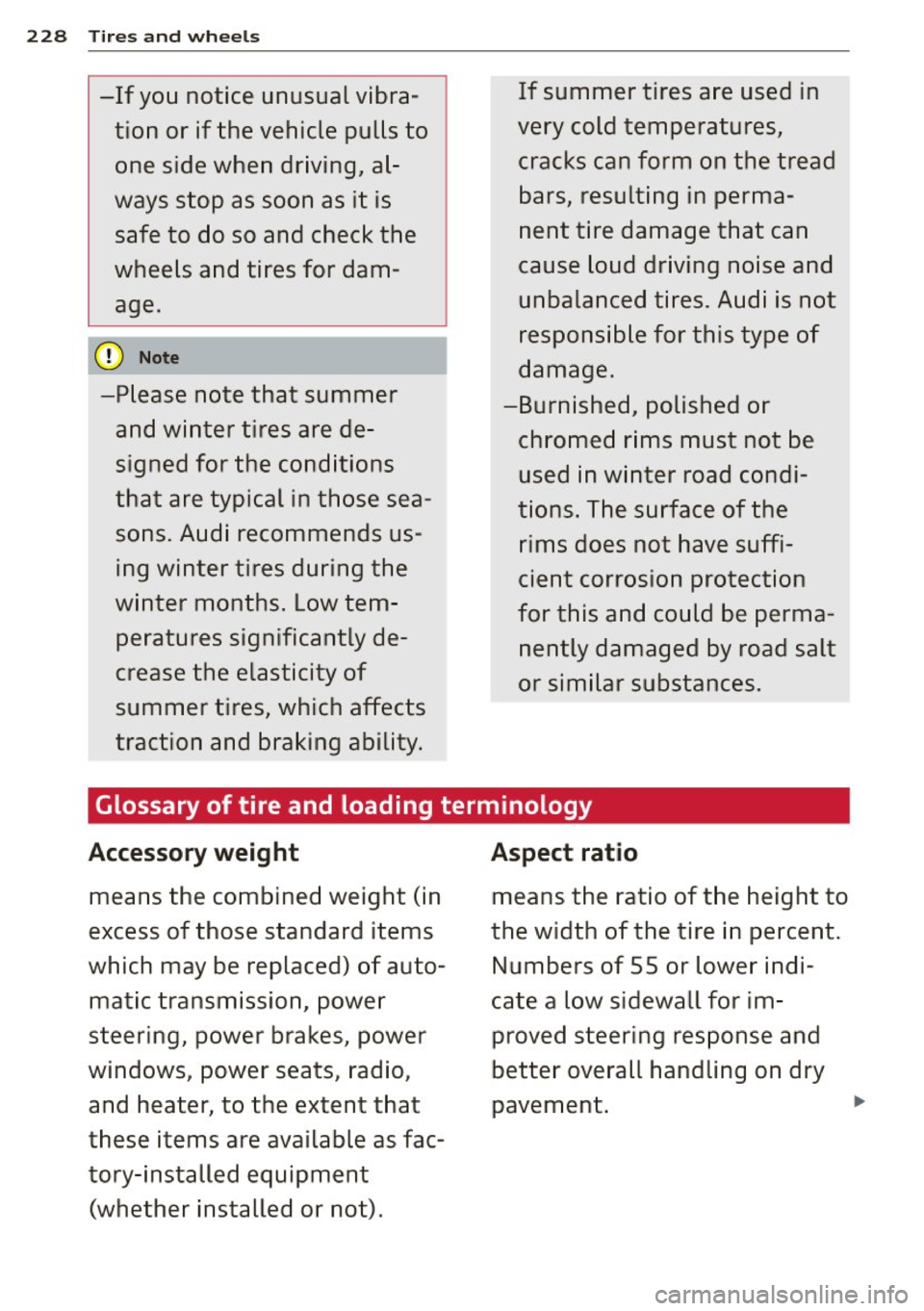
228 Tires and wheels
-If you notice unusual vibra
tion or if the vehicle pulls to
one side when driving, al
ways stop as soon as it is
safe to do so and check the
wheels and tires for dam
age.
0 Note
-Please note that summer and winter tires are de
signed for the conditions
that are typical in those sea
sons. Audi recommends us
ing winter tires during the
winter months. Low tem peratures significantly de
crease the elasticity of
summer tires, which affects
traction and braking ability. If summer tires are used
in
very cold temperatures, cracks can form on the tread
bars, resulting in perma
nent tire damage that can
cause loud driving noise and
unbalanced tires. Audi is not
responsible for this type of
damage.
-Burnished, polished or chromed rims must not be used in winter road condi
tions. The surface of the
rims does not have suffi
cient corrosion protection
for this and could be perma
nently damaged by road salt
or similar substances.
Glossary of tire and loading terminology
Accessory weight
means the combined weight (in
excess of those standard items
which may be replaced) of auto matic transmission, power
steering, power brakes, power
windows, power seats , radio,
and heater, to the extent that
these items are available as fac
tory-installed equipment (whether installed or not).
Aspect ratio
means the ratio of the height to
the width of the tire in percent.
Numbers of 55 or lower indi
cate a low sidewall for im
proved steering response and
better overall handling on dry
pavement.
...